The 2020 iPhone SE
Contents
Apple in April 2020 unveiled a new low-cost iPhone, the iPhone SE, which is a follow-up to the 2016 iPhone SE of the same name. Like its predecessor, the 2020 iPhone SE is Apple's most affordable iPhone, priced starting at $399.
Unlike the original iPhone SE, which resembled an iPhone 5, the 2020 iPhone SE is identical to the iPhone 8 when it comes to design. It has a 4.7-inch Retina HD LCD display with True Tone to match the ambient lighting in a room, Wide color, Dolby Vision, and HDR10.
Available in black, white and (PRODUCT)RED, the iPhone SE is built with a glass front and back with a color-matched aluminum band. Wireless charging is supported and it features IP67 water and dust resistance so it will hold up to splashes and even brief submersions in water.
Because the iPhone SE is physically identical to an iPhone 8, it continues to feature thick top and bottom bezels. The top bezel houses the 7-megapixel front-facing camera and microphone while the bottom bezel includes a Touch ID Home button for fingerprint-based biometric authentication.
The new iPhone SE is the only iPhone in Apple's current lineup that continues to feature Touch ID over Face ID. Like other iPhones, it uses Haptic Touch for Quick Actions and contextual menus, with 3D Touch now eliminated from the iPhone lineup.
There's a single-lens 12-megapixel rear camera in the iPhone SE with an f/1.8 aperture, optical image stabilization, and support for Portrait Mode and Portrait Lighting. Night Mode is not supported, but there is Smart HDR, Wide color support, and more, plus an LED True Tone flash with Slow Sync capabilities.
The iPhone SE's camera can record 4K video at up to 60 frames per second with optical image stabilization and support for slow-mo video and time-lapse video. The front-facing camera supports Portrait Mode as well using the image signal processor and Neural Engine of the A13 Bionic.
Inside, the iPhone SE is equipped with modern chip technology, featuring the same A13 Bionic chip as the iPhone 11, which Apple says is the fastest chip in a smartphone to date. The A13 Bionic has a dedicated 8-core neural engine that can perform 5 trillion operations per second, two Machine Learning Accelerators on the CPU, and a Machine Learning Controller for better performance and efficiency.
When it comes to battery life, the iPhone SE lasts for 13 hours when watching videos, eight hours when streaming videos, and 40 hours when listening to audio. It is capable of fast charging and can charge to 50 percent in 30 minutes when using an 18W power adapter or higher.
There's no U1 chip inside the iPhone SE, but it does feature WiFi 6 support, which is the latest and fastest WiFi protocol, along with Bluetooth 5 and Gigabit-class LTE with 2x2 MIMO. It also has NFC with reader mode and supports Express Cards (transit cards) with a power reserve feature that allows cards to be accessible even when the battery is dead.
The iPhone SE is available in 64, 128, and 256GB capacities. The 64GB model is priced at $399, the 128GB model is priced at $449 and the 256GB model is priced at $549.
How to Buy
Pre-orders for the iPhone SE began on Friday, April 17 at 5:00 a.m. Pacific Time and devices will begin arriving to customers on Friday, April 24. The iPhone SE is launching in the United States and more than 40 other countries and regions.
AppleCare+ is available for the iPhone SE for $79 a year or $3.99 a month, and Apple also offers an upgraded plan $149 plan that also covers theft and loss.
Design
Though named after the 2016 iPhone SE that shared a design with the iPhone 5, the 2020 iPhone SE is identical to the iPhone 8. It features a 4.7-inch display with thick bezels at the top and bottom of the device.
The top bezel features a cutout for the front-facing camera, speaker, and accompanying sensors, and at the bottom of the device, there's a Touch ID Home button covered in sapphire crystal.
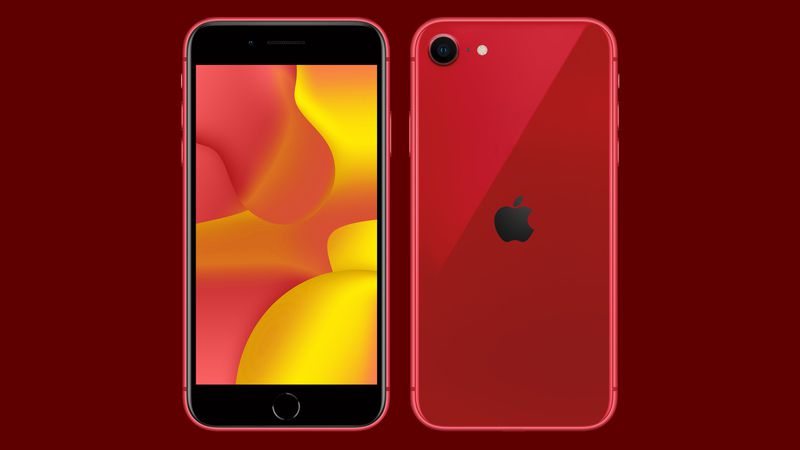
Like the iPhone 8, the iPhone SE has an all-glass body that uses a seven-layer ink process to add color to the glass, resulting in a rich depth of color. The glass display and the glass body are held together by an aluminum band that matches the color of each iPhone for a seamless look, and there are small antenna lines.

The back of the iPhone SE houses a single-lens rear camera, a microphone, and an LED flash.
On the left side of the iPhone SE, there's a mute switch and volume buttons, while the right side features the sleep/wake button. The bottom houses a Lightning port and speaker holes, and like prior iPhones, there is no headphone jack so Bluetooth or Lightning headphones are required.

The 2020 iPhone SE measures in at 138.4mm tall by 67.3mm wide, it's 7.3mm thick, and it weighs 5.22 ounces. It is the smallest of Apple's iPhones, but still much larger than the prior version of the iPhone SE. Because the iPhone SE shares a design with the iPhone 8, cases designed for the iPhone 7 and the iPhone 8 will work with the iPhone SE.
Color Options
The iPhone SE is available in white, space gray and a (PRODUCT)RED version that features a bright red glass-backed shell. All three colors feature black front panels, including the white, which in previous light-colored iPhones was white.

Water and Dust Resistance
The iPhone SE features an IP67 dust and water resistance rating, which means it is entirely dust proof and able to withstand one meter of water (3.3 feet) for up to 30 minutes.
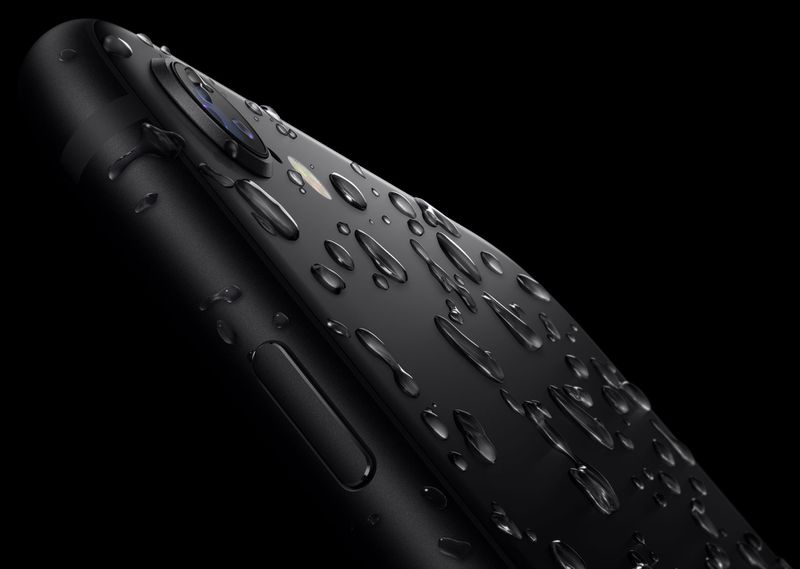
The iPhone SE will hold up to splashes, rain, and brief accidental water exposure, but intentional water exposure should continue to be avoided. Apple warns that water and dust resistance are not permanent conditions and could decrease as a result of normal wear, plus Apple's warranty does not cover any kind of water damage.
Touch ID
Apple's flagship iPhones feature an all-glass design with Face ID, but to keep costs low, the iPhone SE continues to offer a Home button with a Touch ID fingerprint sensor.

The Touch ID Home button is covered with a durable sapphire crystal that protects the Touch ID sensor and a steel ring that detects a user's fingerprint. Touch ID is used for unlocking the iPhone, filling in passwords with iCloud Keychain, confirming App Store purchases, opening passcode-protected apps, and confirming Apple Pay transactions.
Display
The iPhone SE appears to feature the same 4.7-inch display that was used in the iPhone 8 with a resolution of 1334 by 750 with 326 pixels per inch and a 1400:1 contrast ratio.
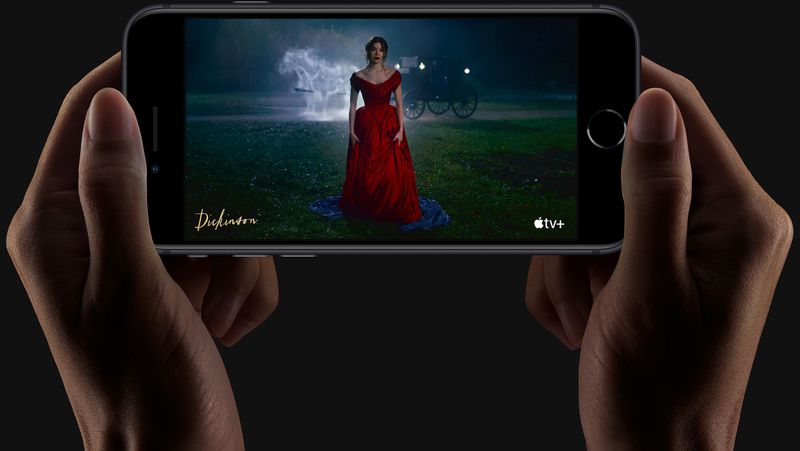
It features multi-touch capabilities, P3 wide color support for rich, true-to-life colors, and 625 nits max brightness.
True Tone
The iPhone SE supports True Tone, a feature that has been included in iPad and iPhone models for several years now.
True Tone takes advantage of the ambient light sensor to detect the lighting in a room, adjusting the color temperature and intensity to match the light for a more natural, paper-like viewing experience that cuts down on eye strain.
Haptic Touch
While the iPhone 8 supported 3D Touch, the iPhone SE offers the same Haptic Touch functionality available in the iPhone 11, 11 Pro, and 11 Pro Max.
Haptic Touch works similarly to 3D Touch and offers a lot of the same functionality, but it is not pressure-sensitive and does not support multiple functions for each press. It is instead better described as a long press or a press and hold gesture with haptic feedback.
Haptic Touch can be used throughout the operating system much like 3D Touch and for many of the same tasks, such as accessing Quick Actions on the Home screen, expanding notification options, previewing links in Safari, activating the flash on the Lock screen, accessing extra features in Control Center, and more.
Our Haptic Touch Guide has more information on the difference between Haptic Touch and 3D Touch and how Haptic Touch can be used.
A13 Bionic
The iPhone SE is equipped with the same A13 Bionic chip that's included in the iPhone 11, 11 Pro, and 11 Pro Max, and which Apple has called its fastest chip ever in a smartphone.
It is much faster than the A11 that was in the iPhone 8, as well as more power-efficient, which improves battery life.
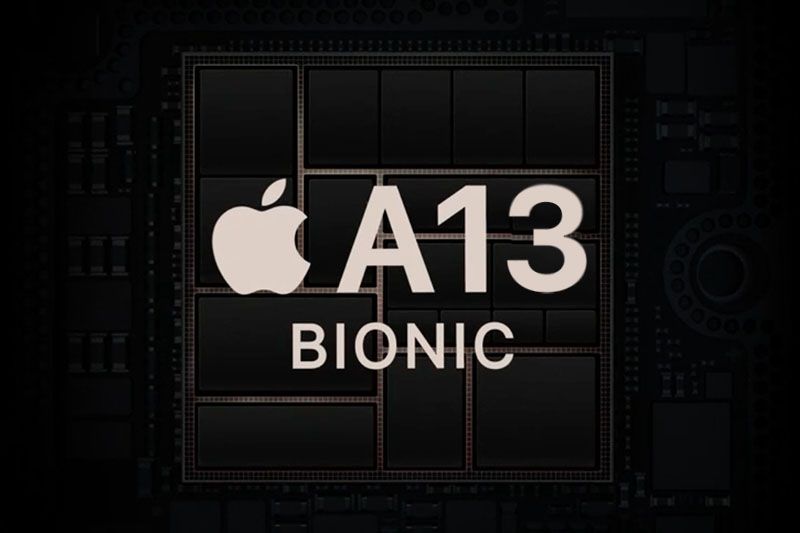
There's an 8-core Neural Engine in the A13 chip, which provides faster than ever real-time photo and video analysis. A pair of Machine Learning Accelerators allow the CPU to run up to six times faster, delivering more than 1 trillion operations per second.
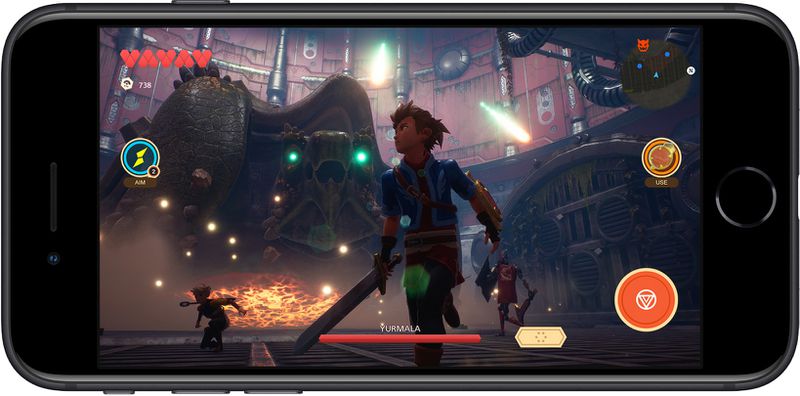
The Neural Engine powers the camera system, Face ID, augmented reality apps, and more, plus there's a new Machine Learning Controller to balance performance and efficiency. According to Apple, the A13 Bionic paired with iOS 13 enables new apps that make use of machine learning and Core ML.
Storage Space
The iPhone SE is available in 64, 128, and 256GB storage options.
RAM
Ahead of when the iPhone SE was released, rumors suggested it had 3GB RAM, and listings from a Chinese carrier have also listed the 3GB RAM number.
Cameras
To keep costs low, the iPhone SE features a single-lens rear camera, but it does adopt some technology from the iPhone 11 and 11 Pro, which means better photos than were possible with the iPhone 8.
The 12-megapixel wide-angle camera features an f/1.8 aperture with optical image stabilization, wide color capture, and next-generation Smart HDR for improved highlights and shadow details. Apple says that it is the best single-camera system ever in an iPhone.

It does not have the same capabilities as the iPhone 11 and 11 Pro do with their multiple camera lenses, so there is no support for Night Mode or optical zoom.
Portrait Mode and Portrait Lighting
While there aren't two cameras, the iPhone SE does support Portrait Mode, Portrait Lighting, and Depth Control using the image signal processor and the Neural Engine for computational photography.
Portrait Mode allows for artful blurring of the background in an image when taking a portrait photo of a person, pet, or object, while Portrait Lighting allows six studio-quality lighting effects to be added to images.
Depth Control allows the amount of blur in an image captured in Portrait Mode to be tuned for the best possible blend of blurring and detail.
Video Capabilities
The iPhone SE shoots 4K video at up to 60 frames per second, with 24 and 30 frames also available options alongside 1080 and 720p shooting modes.
Extended dynamic range support is available for video up to 30 frames per second, and optical image stabilization is available.
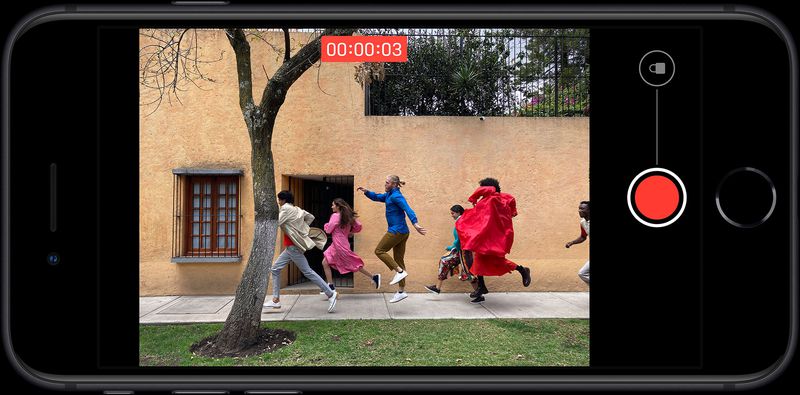
QuickTake video, a feature first introduced in Apple's 2019 flagship iPhones is included, allowing users to capture quick videos by holding down on the camera button when in photo mode.
Existing modes like slo-mo (1080p at 120 or 240 fps) and time-lapse are also available on the iPhone SE.
Front-Facing Camera
The 7-megapixel front-facing camera features an f/2.2 aperture with Portrait mode and Depth Control support despite the lack of a TrueDepth camera system. To enable this feature, Apple uses machine learning and monocular depth estimation.
The front-facing camera supports QuickTake, and it is the first iPhone front-facing camera to offer the feature. 1080p HD video can be recorded at 30 frames per second, and other features include Retina Flash, auto image stabilization, Burst Mode, auto HDR, and wide color capture.
Battery Life
According to a spec sheet from a Chinese telecom, the iPhone SE features an 1,821mAh battery, which is the same battery capacity as the iPhone 8. Apple's own battery listings for the iPhone SE suggest the battery life is "about the same as the iPhone 8."
The iPhone SE's battery lasts for up to 13 hours of video playback, up to eight hours of streaming video playback, and up to 40 hours of audio playback.
Fast Charging
The 2020 iPhone SE supports fast charging, which means it can be charged to 50 percent battery life in just 30 minutes. Fast charging requires a USB-C power adapter that offers at least 18 watts, which includes 29/30W adapters from Apple (priced at $49).
The USB-C power adapter and USB-C to Lightning cable needed for fast charging must be purchased separately because the iPhone SE ships with a standard 5W power adapter and USB-A to Lightning cable.
Wireless Charging
The iPhone SE has a glass body with a built-in wireless charging coil to support Qi-based wireless charging. It is compatible with any 5W or 7.5W Qi-based wireless charging accessory.
Connectivity
Gigabit LTE
The iPhone SE supports Gigabit-class LTE with 2x2 MIMO and LAA like the iPhone 11, and it supports the same LTE bands as the iPhone 11: 1, 2, 3, 4, 5, 7, 8, 12, 13, 14, 17, 18, 19, 20, 25, 26, 29, 30, 66, and 71 FDD‑LTE bands and 34, 38, 39, 40, 41, 42, 46, and 48 TD‑LTE bands.
Dual-SIM Support
Dual-SIM support, which allows two phone numbers to be used at one time, is included in the iPhone SE. Dual-SIM functionality is enabled through the inclusion of one physical nano-SIM slot and an eSIM.
The eSIM feature is available in many countries around the world, and Apple has a full list of carriers that support eSIM on its website.
Dual-SIMs work with select carriers in Austria, Canada, Croatia, Czech Republic, Germany, Hungary, India, Spain, the UK, and the United States.
Bluetooth and WiFi
The iPhone SE supports Bluetooth 5.0, which offers longer range, faster speeds, larger broadcast message capacity, and better interoperability with other wireless technologies compared to Bluetooth 4.2.
It also supports WiFi 6 with 2x2 MIMO, aka 802.11ax WiFi. WiFi 6 is the latest WiFi protocol and it lets you download up to 38 percent faster than WiFi 5 (aka 802.11ac).
GPS and NFC
Support for GPS, GLONASS, Galileo, and QZSS location services is included in the iPhone SE.
NFC with reader mode is included, and there's a background tag feature that allows the iPhone models to scan NFC tags without the need to open an app first. The iPhone SE also supports Express Cards with power reserve, which means it can be used in lieu of a transit card for public transit and will continue to function even if the battery is dead.
What's Next for the iPhone SE
Though the iPhone SE was just released, Apple analyst Ming-Chi Kuo has already shared predictions about its successor, coming in 2021. Kuo expects Apple to introduce an "iPhone SE Plus" with a full-screen design, no Face ID, and a Touch ID fingerprint sensor built into the power button. This device is expected to feature a 5.5 or 6.1-inch LCD display and it will be positioned as a lower-cost iPhone.












